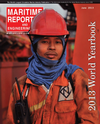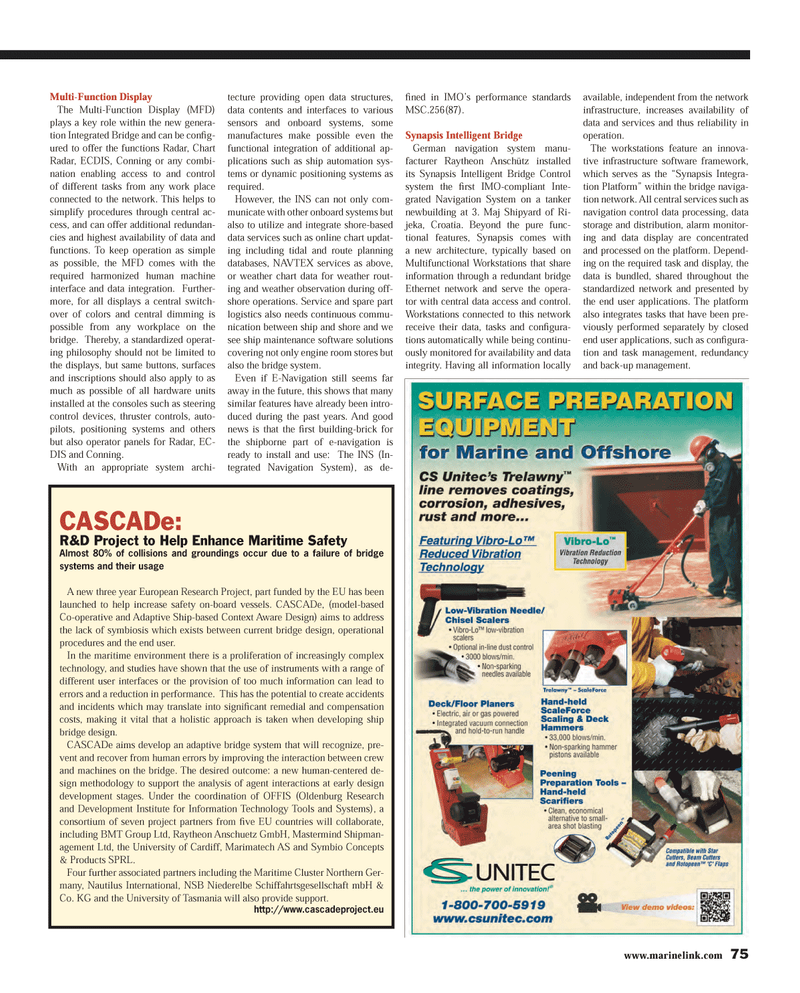
Page 75: of Maritime Reporter Magazine (June 2013)
Annual World Yearbook
Read this page in Pdf, Flash or Html5 edition of June 2013 Maritime Reporter Magazine
www.marinelink.com 75Multi-Function DisplayThe Multi-Function Display (MFD) plays a key role within the new genera-tion Integrated Bridge and can be conÞ g-ured to offer the functions Radar, Chart Radar, ECDIS, Conning or any combi- nation enabling access to and control of different tasks from any work place connected to the network. This helps to simplify procedures through central ac-cess, and can offer additional redundan- cies and highest availability of data and functions. To keep operation as simple as possible, the MFD comes with the required harmonized human machine interface and data integration. Further- more, for all displays a central switch-over of colors and central dimming is possible from any workplace on the bridge. Thereby, a standardized operat- ing philosophy should not be limited to the displays, but same buttons, surfaces and inscriptions should also apply to as much as possible of all hardware units installed at the consoles such as steering control devices, thruster controls, auto-pilots, positioning systems and others but also operator panels for Radar, EC- DIS and Conning. With an appropriate system archi- tecture providing open data structures, data contents and interfaces to various sensors and onboard systems, some manufactures make possible even the functional integration of additional ap-plications such as ship automation sys-tems or dynamic positioning systems as required.However, the INS can not only com- municate with other onboard systems but also to utilize and integrate shore-based data services such as online chart updat-ing including tidal and route planning databases, NAVTEX services as above, or weather chart data for weather rout-ing and weather observation during off- shore operations. Service and spare part logistics also needs continuous commu-nication between ship and shore and we see ship maintenance software solutions covering not only engine room stores but also the bridge system. Even if E-Navigation still seems far away in the future, this shows that many similar features have already been intro-duced during the past years. And good news is that the Þ rst building-brick for the shipborne part of e-navigation is ready to install and use: The INS (In- tegrated Navigation System), as de-Þ ned in IMO?s performance standards MSC.256(87). Synapsis Intelligent BridgeGerman navigation system manu-facturer Raytheon Anschütz installed its Synapsis Intelligent Bridge Control system the Þ rst IMO-compliant Inte- grated Navigation System on a tanker newbuilding at 3. Maj Shipyard of Ri-jeka, Croatia. Beyond the pure func-tional features, Synapsis comes with a new architecture, typically based on Multifunctional Workstations that share information through a redundant bridge Ethernet network and serve the opera-tor with central data access and control. Workstations connected to this network receive their data, tasks and conÞ gura-tions automatically while being continu-ously monitored for availability and data integrity. Having all information locally available, independent from the network infrastructure, increases availability of data and services and thus reliability in operation. The workstations feature an innova-tive infrastructure software framework, which serves as the ?Synapsis Integra-tion Platform? within the bridge naviga-tion network. All central services such as navigation control data processing, data storage and distribution, alarm monitor- ing and data display are concentrated and processed on the platform. Depend-ing on the required task and display, the data is bundled, shared throughout the standardized network and presented by the end user applications. The platform also integrates tasks that have been pre-viously performed separately by closed end user applications, such as conÞ gura-tion and task management, redundancy and back-up management.CASCADe: R&D Project to Help Enhance Maritime Safety Almost 80% of collisions and groundings occur due to a failure of bridge systems and their usageA new three year European Research Project, part funded by the EU has been launched to help increase safety on-board vessels. CASCADe, (model-based Co-operative and Adaptive Ship-based Context Aware Design) aims to address the lack of symbiosis which exists between current bridge design, operational procedures and the end user. In the maritime environment there is a proliferation of increasingly complex technology, and studies have shown that the use of instruments with a range of different user interfaces or the provision of too much information can lead to errors and a reduction in performance. This has the potential to create accidents and incidents which may translate into signiÞ cant remedial and compensation costs, making it vital that a holistic approach is taken when developing ship bridge design.CASCADe aims develop an adaptive bridge system that will recognize, pre-vent and recover from human errors by improving the interaction between crew and machines on the bridge. The desired outcome: a new human-centered de- sign methodology to support the analysis of agent interactions at early design development stages. Under the coordination of OFFIS (Oldenburg Research and Development Institute for Information Technology Tools and Systems), a consortium of seven project partners from Þ ve EU countries will collaborate, including BMT Group Ltd, Raytheon Anschuetz GmbH, Mastermind Shipman- agement Ltd, the University of Cardiff, Marimatech AS and Symbio Concepts & Products SPRL. Four further associated partners including the Maritime Cluster Northern Ger- many, Nautilus International, NSB Niederelbe Schiffahrtsgesellschaft mbH & Co. KG and the University of Tasmania will also provide support. http://www.cascadeproject.eu MR #6 (74-81).indd 75MR #6 (74-81).indd 755/31/2013 10:41:45 AM5/31/2013 10:41:45 AM

 74
74

 76
76
